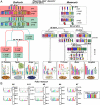Reconstruction of monocotelydoneous proto-chromosomes reveals faster evolution in plants than in animals
- PMID: 19706486
- PMCID: PMC2736418
- DOI: 10.1073/pnas.0902350106
Reconstruction of monocotelydoneous proto-chromosomes reveals faster evolution in plants than in animals
Abstract
Paleogenomics seeks to reconstruct ancestral genomes from the genes of today's species. The characterization of paleo-duplications represented by 11,737 orthologs and 4,382 paralogs identified in five species belonging to three of the agronomically most important subfamilies of grasses, that is, Ehrhartoideae (rice) Panicoideae (sorghum, maize), and Pooideae (wheat, barley), permitted us to propose a model for an ancestral genome with a minimal size of 33.6 Mb structured in five proto-chromosomes containing at least 9,138 predicted proto-genes. It appears that only four major evolutionary shuffling events (alpha, beta, gamma, and delta) explain the divergence of these five cereal genomes during their evolution from a common paleo-ancestor. Comparative analysis of ancestral gene function with rice as a reference indicated that five categories of genes were preferentially modified during evolution. Furthermore, alignments between the five grass proto-chromosomes and the recently identified seven eudicot proto-chromosomes indicated that additional very active episodes of genome rearrangements and gene mobility occurred during angiosperm evolution. If one compares the pace of primate evolution of 90 million years (233 species) to 60 million years of the Poaceae (10,000 species), change in chromosome structure through speciation has accelerated significantly in plants.
Conflict of interest statement
The authors declare no conflict of interest.
Figures



References
-
- Bottjer DJ, et al. Paleogenomics of echinoderms. Science. 2006;314:956–960. - PubMed
-
- Poinar HN, et al. Metagenomics to paleogenomics: Large-scale sequencing of mammoth DNA. Science. 2006;311:392–394. - PubMed
-
- Jackson DJ, et al. Sponge paleogenomics reveals an ancient role for carbonic anhydrase in skeletogenesis. Science. 2007;316:1893–1895. - PubMed
-
- Rensing SA, et al. The Physcomitrella genome reveals evolutionary insights into the conquest of land by plants. Science. 2008;319:64–69. - PubMed
Publication types
MeSH terms
LinkOut - more resources
Full Text Sources
Other Literature Sources
Miscellaneous

